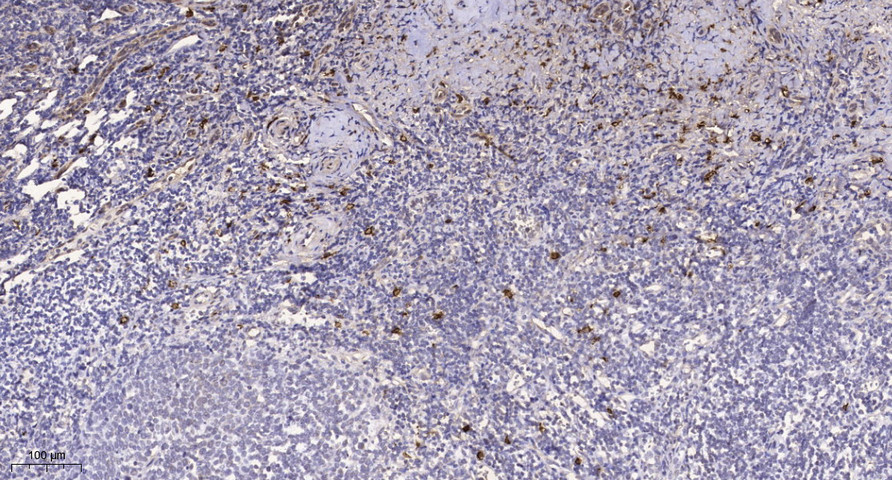MICB Polyclonal Antibody
- Catalog No.:YT6215
- Applications:IHC;IF;WB
- Reactivity:Human
- Target:
- MICB
- Fields:
- >>Natural killer cell mediated cytotoxicity;>>Kaposi sarcoma-associated herpesvirus infection
- Gene Name:
- MICB PERB11.2
- Protein Name:
- MICB
- Human Gene Id:
- 4277
- Human Swiss Prot No:
- Q29980
- Immunogen:
- Synthesized peptide derived from human MICB
- Specificity:
- This antibody detects endogenous levels of human MICB
- Formulation:
- Liquid in PBS containing 50% glycerol, 0.5% BSA and 0.02% sodium azide.
- Source:
- Polyclonal, Rabbit,IgG
- Dilution:
- IHC 1:50-200, WB 1:500-2000. IF 1:50-200
- Purification:
- The antibody was affinity-purified from rabbit antiserum by affinity-chromatography using epitope-specific immunogen.
- Concentration:
- 1 mg/ml
- Storage Stability:
- -15°C to -25°C/1 year(Do not lower than -25°C)
- Other Name:
- MHC class I polypeptide-related sequence B (MIC-B)
- Observed Band(KD):
- 42kD
- Background:
- This gene encodes a heavily glycosylated protein which is a ligand for the NKG2D type II receptor. Binding of the ligand activates the cytolytic response of natural killer (NK) cells, CD8 alphabeta T cells, and gammadelta T cells which express the receptor. This protein is stress-induced and is similar to MHC class I molecules; however, it does not associate with beta-2-microglobulin or bind peptides. Alternative splicing results in multiple transcript variants. [provided by RefSeq, Jan 2014],
- Function:
- disease:Genetic variation in MICB is associated with cytomegalovirus and herpes simplex virus I seropositivity and this may be associated with schizophrenia risk.,disease:The MICA*004 allele is associated with susceptibility to rheumatoid arthritis [MIM:180300]. Rheumatoid arthritis is a complex, multifactorial disorder. It is one of the most common autoimmune diseases and it is characterized by inflammation of synovial tissue and joint destruction.,function:Seems to have no role in antigen presentation. Acts as a stress-induced self-antigen that is recognized by gamma delta T cells. Ligand for the KLRK1/NKG2D receptor. Binding to KLRK1 leads to cell lysis.,induction:By heat shock, oxidative stress, retinoic acid, IFN-alpha and the DNA methyltransferase inhibitor 5-aza-2'-deoxycytidine. Induction by IFN-alpha is impaired in patients with chronic hepatitis C virus infection. Down-regulate
- Subcellular Location:
- Cell membrane ; Single-pass type I membrane protein . Binding to human cytomegalovirus glycoprotein UL16 causes sequestration in the endoplasmic reticulum. .
- Expression:
- Widely expressed with the exception of the central nervous system where it is absent. Expressed in many, but not all, epithelial tumors of lung, breast, kidney, ovary, prostate and colon. In hepatocellular carcinomas, expressed in tumor cells but not in surrounding non-cancerous tissue.
- June 19-2018
- WESTERN IMMUNOBLOTTING PROTOCOL
- June 19-2018
- IMMUNOHISTOCHEMISTRY-PARAFFIN PROTOCOL
- June 19-2018
- IMMUNOFLUORESCENCE PROTOCOL
- September 08-2020
- FLOW-CYTOMEYRT-PROTOCOL
- May 20-2022
- Cell-Based ELISA│解您多样本WB检测之困扰
- July 13-2018
- CELL-BASED-ELISA-PROTOCOL-FOR-ACETYL-PROTEIN
- July 13-2018
- CELL-BASED-ELISA-PROTOCOL-FOR-PHOSPHO-PROTEIN
- July 13-2018
- Antibody-FAQs
- Products Images

- Western blot analysis of lysates from Jurkat cells, primary antibody was diluted at 1:1000, 4°over night

- Immunohistochemical analysis of paraffin-embedded human tonsil. 1, Tris-EDTA,pH9.0 was used for antigen retrieval. 2 Antibody was diluted at 1:200(4° overnight.3,Secondary antibody was diluted at 1:200(room temperature, 45min).



